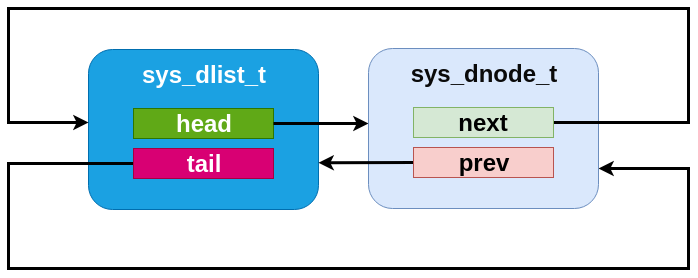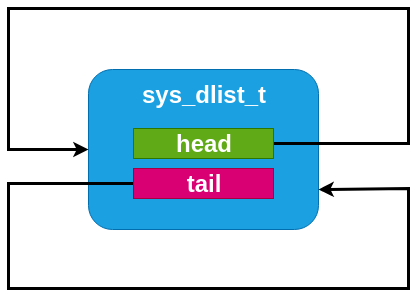Double-linked List
Similar to the single-linked list in many respects, Zephyr includes a double-linked implementation. This provides the same algorithmic behavior for all the existing slist operations, but also allows for constant-time removal and insertion (at all points: before or after the head, tail or any internal node). To do this, the list stores two pointers per node, and thus has somewhat higher runtime code and memory space needs.
A sys_dlist_t struct may be instantiated by the user in any
accessible memory. It must be initialized with sys_dlist_init()
or SYS_DLIST_STATIC_INIT before use. The sys_dnode_t struct
is expected to be provided by the user for any nodes added to the
list (typically embedded within the struct to be tracked, as described
above). It must be initialized in zeroed/bss memory or with
sys_dnode_init() before use.
Primitive operations may retrieve the head/tail of a list and the
next/prev pointers of a node with sys_dlist_peek_head(),
sys_dlist_peek_tail(), sys_dlist_peek_next() and
sys_dlist_peek_prev(). These can all return NULL where
appropriate (i.e. for empty lists, or nodes at the endpoints of the
list).
A dlist can be modified in constant time by removing a node with
sys_dlist_remove(), by adding a node to the head or tail of a list
with sys_dlist_prepend() and sys_dlist_append(), or by
inserting a node before an existing node with sys_dlist_insert().
As for slist, each node in a dlist can be processed in a natural code
block style using SYS_DLIST_FOR_EACH_NODE. This macro also
exists in a “FROM_NODE” form which allows for iterating from a known
starting point, a “SAFE” variant that allows for removing the node
being inspected within the code block, a “CONTAINER” style that
provides the pointer to a containing struct instead of the raw node,
and a “CONTAINER_SAFE” variant that provides both properties.
Convenience utilities provided by dlist include
sys_dlist_insert_at(), which inserts a node that linearly searches
through a list to find the right insertion point, which is provided by
the user as a C callback function pointer, and
sys_dnode_is_linked(), which will affirmatively return whether or
not a node is currently linked into a dlist or not (via an
implementation that has zero overhead vs. the normal list processing).
Double-linked List Internals
Internally, the dlist implementation is minimal: the sys_dlist_t
struct contains “head” and “tail” pointer fields, the sys_dnode_t
contains “prev” and “next” pointers, and no other data is stored. But
in practice the two structs are internally identical, and the list
struct is inserted as a node into the list itself. This allows for a
very clean symmetry of operations:
An empty list has backpointers to itself in the list struct, which can be trivially detected.
The head and tail of the list can be detected by comparing the prev/next pointers of a node vs. the list struct address.
An insertion or deletion never needs to check for the special case of inserting at the head or tail. There are never any NULL pointers within the list to be avoided. Exactly the same operations are run, without tests or branches, for all list modification primitives.
Effectively, a dlist of N nodes can be thought of as a “ring” of “N+1” nodes, where one node represents the list tracking struct.

A dlist containing three elements. Note that the list struct appears as a fourth “element” in the list.

An dlist containing just one element.

An empty dlist.
